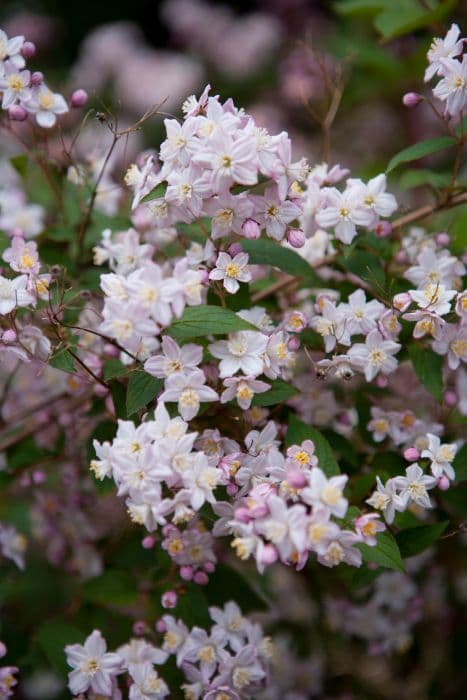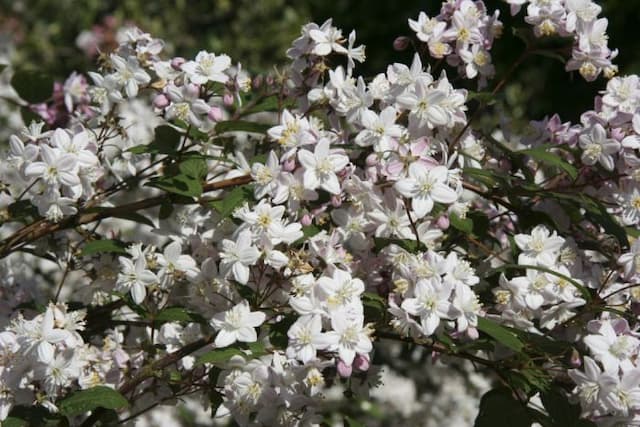Mophead Hydrangea 'Early Sensation' Hydrangea macrophylla 'Early Sensation' (Forever and Ever Series) (H)

ABOUT
'Early Sensation' is a compact, rounded shrub to about 75cm with large heads of blue flowers (purplish-pink on alkaline soil) produced over a long period from early summer to mid-autumn
About this plant
 Names
NamesFamily
Hydrangeaceae.
Synonyms
Bigleaf Hydrangea, French Hydrangea, Lacecap Hydrangea, Mophead Hydrangea, Penny Mac, Hortensia.
Common names
Hydrangea macrophylla 'Early Sensation'.
 Characteristics
CharacteristicsLife cycle
Perennials
Foliage type
Deciduous
Color of leaves
Green
Flower color
Varies
Height
3-4 feet (91-122 cm)
Spread
3-4 feet (91-122 cm)
Plant type
Shrub
Hardiness zones
5
Native area
Japan
Benefits
 General Benefits
General Benefits- Continuous Blooms: Hydrangea macrophylla 'Early Sensation' produces flowers from early summer until fall, providing a long season of color.
- Reblooming Variety: It has the ability to bloom on both old and new wood, ensuring flowers even after a harsh winter or improper pruning.
- Vibrant Colors: Flowers range from pink to blue depending on the soil pH, offering a variety of colors for different garden themes.
- Compact Size: It is suitable for small gardens or spaces, as it remains a manageable size.
- Attracts Pollinators: The blooms attract bees and butterflies, promoting biodiversity in the garden.
- Low Maintenance: Requires minimal care once established, making it ideal for beginner gardeners or those with limited time.
- Versatility: Can be used in borders, containers, or as a focal point in the garden for versatile landscaping options.
- Hardiness: It is resilient in a range of climates and can tolerate cold temperatures once established.
 Medical Properties
Medical PropertiesThis plant is not used for medical purposes.
 Air-purifying Qualities
Air-purifying QualitiesThis plant is not specifically known for air purifying qualities.
 Other Uses
Other Uses- Pressed Flower Art: The vibrant colors of hydrangea flowers make them excellent for creating pressed flower art or botanical prints.
- Bookmarks: Dried hydrangea petals can be laminated to create unique and decorative bookmarks.
- Crafting Potpourri: Dried hydrangea flowers can be mixed with other botanicals to create a fragrant potpourri.
- Hydrangea Tea Parties: Some enthusiasts use the flowers as a theme for garden tea parties, incorporating their colors and shapes into the decor.
- Color Changing Experiment: The flower's ability to change color depending on soil pH can be used as an educational tool to teach about soil chemistry.
- Natural Dyes: Hydrangea blooms can be used to create natural dyes for fabrics or Easter eggs.
- Floral Bath Salts: Dried hydrangea petals can be mixed with bath salts to create a luxurious bathing experience.
- Garden Photography: Hydrangeas can serve as stunning subjects or backdrops for garden photography enthusiasts.
- Ice Cubes: Freeze small hydrangea flowers in ice cubes for an elegant touch to drinks at special events.
- Candle Embedding: Small dried hydrangea flowers can be embedded into candles for decoration.
Interesting Facts
 Feng Shui
Feng ShuiThe Hydrangea is not used in Feng Shui practice.
 Zodiac Sign Compitability
Zodiac Sign CompitabilityThe Hydrangea is not used in astrology practice.
 Plant Symbolism
Plant Symbolism- Heartfelt Emotions and Gratitude: The hydrangea is often associated with expressing genuine, deep-seated emotions and can symbolize gratitude for understanding.
- Apology or Forgiveness: Due to its lush and abundant flower heads, the hydrangea can symbolize an apology or a request for forgiveness, as it offers an extravagant visual apology.
- Vanity or Frivolity: In certain cultures, hydrangeas have a negative connotation and can represent vanity or boastfulness, possibly because of their showy appearance.
- Perseverance: The hydrangea's ability to bloom and re-bloom throughout the seasons can symbolize perseverance and resilience.
- Abundance: With its full, bountiful clusters of flowers, the hydrangea can represent abundance and prosperity.
- Fourth Anniversary: Hydrangeas are often given as gifts for the fourth wedding anniversary to symbolize appreciation and enduring love.
 Water
WaterBigleaf hydrangeas should be watered deeply and thoroughly, saturating the soil around the root zone. Watering frequency depends on weather conditions, but generally, aim for about 1 inch of water per week, either from rainfall or through manual watering. During particularly hot or dry periods, you may need to water two to three times weekly to maintain moist soil. Overhead watering should be avoided to decrease the chance of leaf diseases; instead, use a soaker hose or drip irrigation at the base of the plant. It's essential not to overwater, as this can lead to root rot, so ensure proper drainage is in place.
 Light
LightBigleaf hydrangeas thrive best in a spot with morning sun and afternoon shade, especially in hotter regions. An eastern-facing location that offers sunlight in the morning and protection from the harsh afternoon sun will optimize their growth and bloom production. Too much direct sunlight can cause leaf scorch, while too much shade can reduce flowering.
 Temperature
TemperatureBigleaf hydrangeas prefer a moderate temperature range, usually between 60°F and 75°F. They can tolerate minimum temperatures down to around 5°F with proper winter protection and can handle maximum temperatures up to about 85°F, though prolonged heat can stress them. Ideal growing conditions involve warm days and cool nights.
 Pruning
PruningPrune bigleaf hydrangeas immediately after flowering to remove spent blooms and encourage bushiness. They bloom on old wood, so late winter or early spring pruning can remove flower buds. Annually remove one-third of the oldest stems to rejuvenate and promote healthy growth. Pruning is necessary to prevent overgrowth and to remove any dead or damaged branches that can harbor disease.
 Cleaning
CleaningAs needed
 Soil
SoilThe Bigleaf Hydrangea prefers soil that is moist but well-draining, rich in organic matter, and slightly acidic with a pH between 5.0 and 6.5. A mix of garden soil, peat moss, and compost is beneficial. Adjust pH with sulfur or peat for bluer flowers, or lime for pinker hues.
 Repotting
RepottingBigleaf Hydrangea should be repotted when it outgrows its container, typically every 2-3 years. Spring is the best time to repot to allow the plant to settle in before the growing season.
 Humidity & Misting
Humidity & MistingBigleaf Hydrangea thrives in moderate to high humidity levels. Aim for 50-60% relative humidity for optimal growth and flowering.
 Suitable locations
Suitable locationsIndoor
Place near bright window; water when topsoil feels dry.
Outdoor
Plant in part shade, shelter from strong winds, keep soil moist.
Hardiness zone
5-9 USDA
 Life cycle
Life cycleThe Hydrangea macrophylla 'Early Sensation', commonly known as Forever and Ever Hydrangea, begins its life cycle when a seed germinates in the spring, growing into a seedling with characteristic broad leaves. It quickly progresses into the vegetative stage, developing a robust root system and lush foliage. In the flowering stage, which occurs in early to mid-summer, the plant produces large mophead flowers that are pink, blue, or purple, depending on soil pH. After pollination, seeds are formed, and as the growing season ends, the plant enters a period of dormancy during the colder months. The hydrangea relies on energy reserves to survive winter and resumes growth in the following spring, with established plants often showing more vigorous and abundant blooming. The plant can live for many years, repeating this cycle annually, with proper care and favorable conditions.
 Propogation
PropogationPropogation time
Spring-Early Summer
Hydrangea macrophylla 'Early Sensation', commonly referred to as Bigleaf Hydrangea, can be propagated most effectively through softwood cuttings taken in late spring or early summer when the plant's new growth is still tender and pliable. A popular method includes selecting a healthy stem that has not flowered, cutting a section 5 to 6 inches long with several leaves, and dipping the cut end into a rooting hormone. The cutting should then be planted in a mixture of peat and perlite, ensuring that the bottom leaves are just above the surface. It is critical to maintain a humid environment for the cutting by covering it with a plastic bag or placing it in a propagator, keeping the soil lightly moist but not waterlogged. Roots typically develop within 2 to 4 weeks, after which the new plants can be gradually acclimatized to less humid conditions before being planted out.








![Hydrangea [Early Sensation]](/_next/image?url=https%3A%2F%2Fplants-admin.emdemapps.com%2Fimages%2Fplants%2F%2Fimages%2F604b6150338db.png&w=640&q=75)
